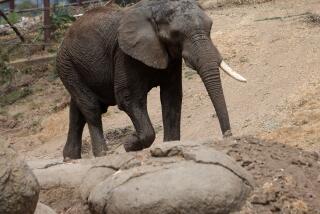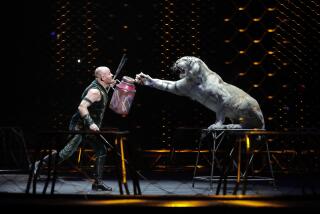Root-Canal Specialists Add Endangered Species to Client List
- Share via
SEATTLE — To Dr. James McGraw, an animal’s bite is often just as important as its bark.
That’s why the Bellevue endodontist urges other dentists to join him in volunteering to perform root canals and other dental procedures on rare zoo animals and other endangered creatures.
Animals with healthy teeth tend to live longer and happier lives, McGraw says.
“This is about the endodontist’s role in helping the world’s great animals, for whom time is running out,” McGraw said at the annual conference of the American Assn. of Endodontists--root-canal specialists--held here earlier this year.
McGraw volunteers at Seattle’s Woodland Park Zoo in addition to tending his private practice for human patients and teaching dentistry at the University of Washington.
He estimates that he’s performed dental procedures on hundreds of zoo animals since working on his first nonhuman patient--a baboon with a broken tooth--in 1970.
“The procedures [on animals] have changed only so much as dentistry in general has, because we provide the same quality of care at the zoo that humans get,” McGraw said in a recent interview at Woodland Park that he cut short to clean a rare Sumatran tiger’s teeth.
Nowadays, he said, “There are better materials, more sophisticated restorations, more sophisticated sealants and filler materials, and . . . that’s come [to animals] at the same rate that it’s come to humans.”
The tools for root canals and other procedures are essentially the same for animals as for humans.
Sometimes the equipment must be custom-made due to the animal’s size.
Other times, one has to improvise. Dr. William Powell, an endodontist who volunteers at the Knoxville Zoo, once performed a root canal on an elephant’s broken tusk. Among his instruments: an ice pick, a broom handle and a PCV--positive crankcase ventilation tube, normally used in auto exhaust systems to curb pollutants.
An animal’s teeth can be crucial to survival in the wild.
Animals use their teeth to eat, communicate, defend themselves and mark their social status. So when a tooth is damaged, the animal can be at a severe disadvantage.
In humans, the loss of a tooth can lead to problems such as shifting of other teeth and gum disease. But loss of a tooth for a lion or bear can be fatal. It can cause the animal to stop eating, become antisocial or develop an infection.
“When you come right down to it . . . a great majority [of big animals] are lost in the wild due to dental disease,” said Dr. Bert Kaufman, a Woodland Hills dentist who volunteers at the Wildlife Waystation in Angeles National Forest as well as at the Los Angeles Zoo.
“If they break a tooth and it gets infected, they don’t have antibiotics.”
Dr. Paul Brown, an endodontist who volunteers at the San Francisco Zoo, recently worked on a Kodiak bear that had mysteriously lost several hundred pounds and was “on its way to dying.”
It turned out the bear had fractured a cuspid and was packing food in the opening instead of swallowing it. After a root canal and some sealant, the animal was on its way to recovery.
“I think it would be a great asset if all zoos used people like us,” said Brown, whose nonhuman patients have included whales, elephant seals, camels and even the Exxon tiger.
“It’s only beneficial to animals,” he said.
“Animals can’t maintain their teeth with brushing, as we can,” said Dr. John Scheels, who volunteers at the Milwaukee County Zoo in Wisconsin. “So much of human treatment is predicated on home care and personal hygiene. You can’t expect an animal to get that.”
Scheels, who helped put together the first meeting of an exotic-animal veterinary dentistry group in Milwaukee in 1986, estimates that there are 40 or 50 dentists who work with zoos, but only about 10 who do it regularly.
Endangered animals in zoos often outlive their cohorts in the wild because of human health-care intervention, he said.
“We’re extending their life span and particularly their reproductive-health life spans,” Scheels said.
Dr. Janice Joslyn, senior veterinarian at Woodland Park Zoo, says McGraw’s volunteer work has helped prolong the lives of many of the zoo’s animals.
“When I was in vet school 20 years ago, we were taught just to pull the teeth out if they looked bad or broken,” she said.
Now it’s recognized that animals--like people--do better if a damaged tooth is saved, she said.
“We’re working with animals that aren’t going to brush their teeth and floss, and there’s no way I can tell them to do that,” Joslyn said, adding, “We want our animals to live long and be healthy and reproduce.”
Animals may need root canals or other procedures because they break their teeth on rocks or other hard objects, or damage them in falls or skirmishes with other animals.
As with human teeth, a root canal saves the animal’s tooth by removing infected or damaged soft inner tissue and replacing it with a filling material, usually soft, rubbery stuff called gutta percha.
While a human tooth requires just a few milligrams of gutta percha, an elephant’s tusk can require a wheelbarrow full.
Most animals are model dental patients. Once anesthetized, they are easy to work on. They don’t complain or squawk about the bill.
But there can be complications that don’t arise with humans.
Kaufman recalls working on a big male jaguar named George at the Wildlife Waystation.
“We extracted a lower canine that took about two hours. While we were waiting for the handler to put him back in the cage, George woke up, jumped up and ran onto the floor.”
Kaufman was trampled as some of his colleagues made a beeline for the door.
“You’ve never seen eight people in a room move so fast,” he said.
The vet managed to get a noose on George and guide him into his transfer cage without incident.
“I’ve seen psychotic animals. I’ve seen absolutely normal animals. I’ve seen very loving animals,” Kaufman said.
“But you have to keep in mind, these are all wild animals.”
And often rare or even endangered, which is why McGraw and his colleagues are pitching in to help save them.
“You just can’t allow rare animals, a red panda or something, to die merely because you were unable to give it the attention it needed,” McGraw said.
More to Read
Sign up for Essential California
The most important California stories and recommendations in your inbox every morning.
You may occasionally receive promotional content from the Los Angeles Times.













